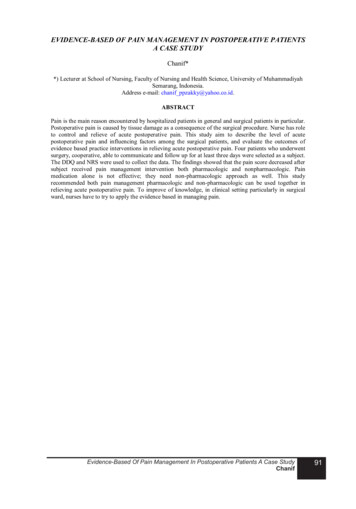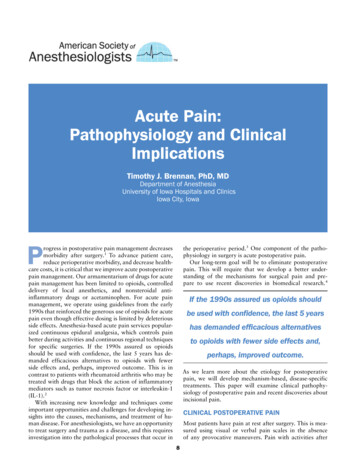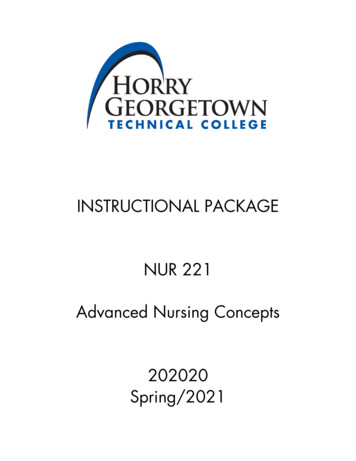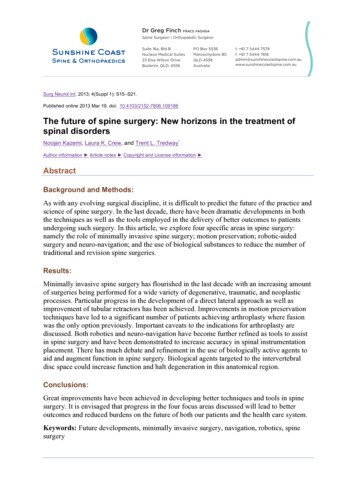
Transcription
COREMetadata, citation and similar papers at core.ac.ukProvided by Boston University Institutional Repository (OpenBU)Boston UniversityOpenBUhttp://open.bu.eduTheses & DissertationsBoston University Theses & Dissertations2017The effect of postoperativekeratometry on visual acuity aftercorneal refractive laser surgeryhttps://hdl.handle.net/2144/23728Boston University
BOSTON UNIVERSITYSCHOOL OF MEDICINEThesisTHE EFFECT OF POSTOPERATIVE KERATOMETRY ON VISUAL ACUITYAFTER CORNEAL REFRACTIVE LASER SURGERYbyDALLAS J. PETERSB.S., University of California Irvine, 2013Submitted in partial fulfillment of therequirements for the degree ofMaster of Science2017
2017 byDALLAS J. PETERSAll rights reserved
Approved byFirst ReaderLouis Gerstenfeld, Ph.D.Professor of Orthopaedic SurgerySecond ReaderSamir Melki, M.D., Ph.D.Associate Professor of Ophthalmology, Part-TimeHarvard Medical SchoolFounder and Director, Boston Eye Group
DEDICATIONI dedicate this work to my family, specifically my parents and sister, for theirunwavering support of all of my endeavors.iv
ACKNOWLEDGMENTSTo Dr. Gwynneth Offner, for her advice and guidance as my program director.To Dr. Louis Gerstenfeld, for his time as my advisor and reader of this thesis.To Dr. Samir Melki, for the opportunity to work with him in a research and clinicalsetting and learn from his expertise as an ophthalmologist and eye surgeon.To Mr. David Flynn, for his help with literature search tactics and thesis formatting tips.To Dr. Hrag Janbatian, Michael Nitz, Dr. Si-Liang Peng, and Stephanie Saadeh forresearch advice and assistance with statistical analysis of results.To my co-workers at Boston Eye Group, for their patience and help throughout mytraining and work at the medical practice.To my roommate Akila Raja, for always helping me keep life in perspective andsupplying me with endless pizza and puns.v
THE EFFECT OF POSTOPERATIVE KERATOMETRY ON VISUAL ACUITYAFTER CORNEAL REFRACTIVE LASER SURGERYDALLAS J. PETERSABSTRACTPURPOSE: To determine if there is a relationship between eyes with flat corneas (asdefined by calculated postoperative keratometry values of 38D) undergoing eitherLASIK (Laser-assisted in Situ Keratomileusis), LASEK (Laser-assisted SubepithelialKeratectomy), or PRK (Photorefractive Keratectomy) corneal refractive surgery and lossof 1 or more lines of postoperative BCVA, and if there is an advantage to undergoingeither LASIK or ASA in eyes meeting flat cornea criteria.METHODS: A retrospective analysis of 191 candidate eyes with calculatedpostoperative keratometry values 38D were identified and matched by manifestrefraction and surgery type to 191 control eyes with calculated postoperative keratometryvalues 38D. Both candidate groups and control groups were further stratified intosubgroups based on degree of calculated postoperative keratometry. Candidatesubgroups: Subgroup 1a (K 35D), Subgroup 2a (K 35-35.99D), Subgroup 3a (K 3636.99D), and Subgroup 4a (K 37-37.99D). Control subgroups: Subgroup 1b (K 3838.99D), Subgroup 2b (K 39-39.99D), Subgroup 3b (K 40-40.99D) and Subgroup 4b(K 41D). All patients had undergone corneal refractive eye surgery procedures LASIK,LASEK, or PRK at Boston Eye Group/Boston Laser in Brookline MA betweenDecember 2008 and November 2016. All LASIK flaps were created using thevi
femtosecond laser IntraLase iFS60 Laser (Abbott Medical Optics Inc.). All surfaceablation procedures were performed using the excimer lasers VISX STAR S4 IR ExcimerLaser System (Abbot Medical Optics Inc.) or WaveLight EX500 Excimer Laser (AlconLaboratories Inc.). Visual acuity outcomes measuring preoperative and postoperativeBCVA and loss of BCVA were recorded as part of the patient’s medical chart and werestatistically analyzed to determine correlations.RESULTS: Our data showed no significant differences between overall candidate(K 38D) and control (K 38D) group mean preoperative BCVA (p 0.23) or meanpostoperative BCVA (p 0.13). A total of 15 out of 191 (7.9%) candidate eyes lost 1 ormore lines of BCVA in comparison to 23 total control eyes (12.0%) that lost 1 or morelines of BCVA postoperatively. When evaluating subgroup data, Candidate Subgroup 1a(K 35D) showed a significant (p 0.02) decrease in BCVA when compared to othercandidate subgroups. Additionally, Control Subgroup 1b (K 38 38.99D) and ControlSubgroup 2b (39-39.99D) showed a significant (p 0.001 and p 0.02 respectively)decrease in BCVA compared to other control subgroups. A total of 231 total candidateand control eyes underwent LASIK and a total of 151 total candidate and control eyesunderwent ASA. Overall, 17 out of the 231 (7.4%) eyes undergoing LASIK lost BCVAcompared to the 21 out of 151 (13.9%) eyes undergoing ASA that lost BCVA which wassignificant (p 0.04).CONCLUSION: This study did not find evidence to support that the overall flat corneagroup (K 38D) lost postoperative BCVA when compared to a control group of eyes withnormal keratometry values. However, our data indicated that when the candidate groupvii
was stratified by degree of corneal curvature, patients with very flat corneas (K 35D)may be at increased risk of losing BCVA though further studies are needed. Additionally,eyes undergoing ASA may be at increased risk of losing BCVA though further studiesare needed.viii
TABLE OF CONTENTSTITLE .iCOPYRIGHT PAGE .iiREADER APPROVAL PAGE .iiiDEDICATION . ivACKNOWLEDGMENTS . vABSTRACT. viTABLE OF CONTENTS. ixLIST OF TABLES . xiiLIST OF FIGURES . xivLIST OF ABBREVIATIONS . xvINTRODUCTION . 1Types of Refractive Error . 1Types of Vision Correction. 4LASIK . 7LASEK. 7PRK . 8Candidates for Refractive Surgery . 8The Cornea and Corneal Refractive Laser Surgery . 9Visual Acuity and Keratometry . 12ix
SPECIFIC AIMS . 18METHODS . 20Study Design Overview . 20Postoperative Keratometry Calculation . 20Clinical Laser Vision Correction Surgical Consultation Procedures . 21Pre-Operative Workup . 22Intra-Operative LASIK Procedure . 23Intra-Operative Advanced Surface Ablation (LASEK and PRK) Procedure . 25Post-Operative Procedure and Directions for LASIK . 28Post-Operative Procedure and Directions for Advanced Surface Ablation . 29Follow-Up Procedures . 30LASIK Follow-Up . 31Advanced Surface Ablation Follow-Up. 31Data and Statistical Analysis . 32RESULTS . 34Preoperative Data . 34Postoperative Data . 37Loss of BCVA . 39Follow-Up Data . 41Surgery Type. 43Intraoperative Complications . 45DISCUSSION . 48x
Candidate-Control Matching . 48Overall Loss of BCVA. 48Subgroup Loss of BCVA . 50Surgery Type. 54Current Study Limitations and Future Studies. 55REFERENCES . 58CURRICULUM VITAE . 63xi
LIST OF TABLESTable1TitleBoston Eye Group/Boston Laser Postoperative LASIKPage29Eye Drop Regimen2Boston Eye Group/Boston Laser Postoperative LASEK30and PRK Eye Drop Regimen3Snellen Visual Acuity Chart Conversion to LogMAR32Equivalent4Candidate and Control Stratified Subgroups and36Preoperative BCVA5Candidate and Control Stratified Subgroups and38Postoperative BCVA6Candidate Eyes That Lost BCVA by Subgroup and40Relative Frequency of Total Subgroup Population7Control Eyes That Lost BCVA by Subgroup and Relative40Frequency of Total Subgroup Population8Candidate Subgroup Mean Preoperative and Postoperative41BCVA Comparison9Control Subgroup Mean Preoperative and Postoperative41BCVA Comparison10Candidate Subgroup Follow-Up Durationxii42
11Control Subgroup Follow-Up Duration4212Candidate Surgery Type by Subgroup4313Control Surgery Type By Subgroup4314Eyes Within Candidate Subgroups Experiencing46Intraoperative Complications15Eyes Within Control Subgroups ExperiencingIntraoperative Complicationsxiii47
LIST OF FIGURESFigureTitlePage1Phoropter (Refractor)132Candidate vs. Control Preoperative Visual Acuity353Candidate vs. Control Postoperative Visual Acuity374Candidate vs. Control Loss of BCVA39xiv
LIST OF ABBREVIATIONSAC.Anterior ChamberASA.Advanced Surface AblationBCL.Bandage Contact LensBCVA.Best Corrected Visual AcuityBSS.Balanced Salt SolutionCDVA.Corrected Distance Visual AcuityCRLS.Corneal Refractive Laser SurgeryD.DioptersDES.Dry Eye SyndromeFDA.Food and Drug AdministrationICL.Implantable Contact LensIOL.Intraocular LensIOP.Intraocular PressureK.Keratometry Value (in Diopters)LASEK.Laser-assisted Subepithelial KeratectomyLASIK.Laser-assisted in Situ KeratomileusisMMC.Mitomycin CNSAID.Nonsteroidal Anti-Inflammatory DrugOCT.Ocular Coherence TomographyPRK.Photorefractive KeratectomyPTA.Percentage of Tissue to be Alteredxv
RSB.Residual Stromal BedUCVA.Uncorrected Visual AcuityVA.Visual Acuityxvi
1INTRODUCTIONIt is estimated that over 1 billion people worldwide currently suffer from poorvision related to correctable refractive errors, also known as ametropia (Durr et al., 2014).With approximately 75% of Americans currently requiring some sort of correctiveeyewear, and that number expected to grow due to an aging population and increasingprevalence of chronic diseases linked to unhealthy lifestyles (“NHIS - Tables ofSummary Health Statistics,” 2015), correcting ocular refractive errors will continue to beessential in the United States. The four most common types of refractive error in the USare myopia, hyperopia, presbyopia, and astigmatism.Types of Refractive ErrorIn a normal healthy eye with no refractive error, beams of distant light enter theeye through the cornea where they are refracted through the lens in such a way so thefocal point of those beams of light sits directly on the retina. This normal vision is alsoknown as emmetropia.Myopia, also called nearsightedness, is a condition where the individual can seeclose objects clearly but experiences blurred vision when looking at objects farther away.This occurs because the refracting power of the cornea and lens is too strong, causing thebeams of distant light entering the eye to be refracted too strongly so the focal point ofthose beams of light sits in front of the retina. In many cases, a contributing factor to thisincreased refracting power is a change in shape of the eyeball itself in such a way that theaxial length is increased (Bastawrous, Silvester, & Batterbury, 2011). Myopia can becorrected by placing a spherical diverging (concave) lens in front of the ocular surface to
2bend the entering beams of distant light in such a way as to move their focal point back torest normally on the retina.Hyperopia, also called hypermetropia or farsightedness, is a condition where theindividual can see objects that are far away clearly, but experiences blurred vision whenlooking at near objects. This occurs because the refracting power of the cornea and lens istoo weak, causing the beams of distant light entering the eye to be refracted too weaklyso the focal point of those beams of light sits theoretically behind the retina. In manycases, a contributing factor to this decreased refracting power is a change in shape of theeyeball itself in such a way that the axial length is decreased (Bastawrous, Silvester, &Batterbury, 2011). Hyperopia can be corrected by placing a spherical converging(convex) lens in front of the ocular surface to bend the entering beams of distant light insuch a way as to move their focal point forward to rest normally on the retina.Presbyopia, also called age-related farsightedness, is a condition similar tohyperopia in that individuals can see objects that are far away clearly, but experiencesblurred vision when looking at near objects. This occurs when the lens of the eye loseselasticity and becomes more rigid with age (Michael & Bron, 2011). This loss ofelasticity correlates with an inability for the lens to change shape, also calledaccommodation, and thus loses refracting power (Cochrane, du Toit, & Le Mesurier,2010). This weak refracting power results in the same condition as hyperopia with thefocal point of entering beams of distant light sitting behind the retina (Bastawrous,Silvester, & Batterbury, 2011). Presbyopia typically onsets in the mid-40s and worsensuntil age 65 (Boyd, 2013). It is corrected in the same manner as hyperopia by placing a
3spherical converging (convex) lens in front of the ocular surface to bend the enteringbeams of distant light in such a way as to move their focal point forward to rest normallyon the retina (Dowling & Dowling, 2016).Astigmatism is a condition that affects individuals suffering from by myopia orhyperopia where either the corneal surface of the eye or the curvature of the lens withinthe eye is irregularly shaped (Marcos et al., 2015). These two defects are called cornealastigmatism and lenticular astigmatism respectively. Shape irregularities in either thecornea or lens cause the beams of distant light entering the eye to refract in an irregularway, producing multiple focal points that do not all sit directly on the retina. This causesvision to become blurred at any distance. Astigmatism can further be divided intoadditional subgroups: regular and irregular astigmatism.Regular astigmatism includes: simple (one focal point always resting on the retinawith one focal point resting behind the retina), compound (both focal points resting eitherin front or behind the retina), and mixed astigmatism (one focal point resting in front ofthe retina and one focal point resting behind the retina). Irregular astigmatism isastigmatism that is caused by some sort of irregularity of the cornea either by trauma,inflammation, scarring, or a developmental defect, which causes the cornea to deviateand change shape away from its normally expected curvature (Stein, Stein, & Freeman,2013).Regular astigmatism can be corrected by placing a special cylindrical lens in frontof the ocular surface, which compensates for the irregular shape of the cornea or the lensand helps to focus the beams of distant light into a line instead of a point on the retina
4(Stein, Stein, & Freeman, 2013). Irregular astigmatism, however, is much more difficultto treat and is often times not fully correctable using a cylindrical lens.Types of Vision CorrectionBy far, the most common type of refractive error correction is corrective eyewear,or glasses. Over 150 million Americans currently wear some sort of corrective eyewear(“Eye Health Statistics,” n.d.). This is a very effective first step in vision correction,however, users can experience problems with wearing glasses. Depending on how highthe prescription is, users can experience image distortion (Silberner, 1980) includingimage shrinking. Additionally, glasses can be cumbersome, expensive, and can break orbe lost easily.Another popular way to correct refractive errors is by utilizing prescriptioncontact lenses. Contact lenses commonly come in two varieties: silicone or fluoropolymersoft lenses and rigid gas-permeable lenses (RGP). Contact lenses can be an excellentoption to improve quality of life for individuals since they are easy to use and reducedependence on glasses. However, contact lens users are also at risk for a number ofcomplications. If contact lenses fit incorrectly, they can put an abrasive force on theocular surface and increase the risk of corneal abrasion and neovascularization of thecornea (Boyd, 2016). Additionally, improper care can lead to increased risk for contactlens associated dry eyes and eye infections including conjunctivitis, keratitis andblepharitis (Stuart, 2012). These conditions can cause trauma or inflammation of thecornea, which can change the anterior corneal curvature, also called keratometry of thecornea, and lead to irregular astigmatism.
5A semi-permanent way to correct refractive errors can be found in ImplantableContact Lenses (ICLs). While glasses and contact lenses are a good choice for the entireprescription spectrum from mild to strong lens prescriptions, ICLs are usually onlyrecommended for moderately severely myopic (less than -4D) or hyperopic (less than 4D) individuals (Koivula & Zetterström, 2009). ICLs work by surgically opening theeye and implanting a phakic intraocular lens (IOL) either in front or behind the iris(Koivula & Zetterström, 2009). In either case, the ICL is placed in front of the naturallens. One positive aspect of ICLs is that if an individual’s visual acuity worsens, a newICL of different refractive strength may be exchanged for the previously implanted one.However, ICLs present an increased risk of development of cataracts due to the ICLrubbing on the natural lens. Additionally, ICL users are at increased risk of infection andinflammation at the surgical site, pupillary block, endothelial cell death, as well aspotential decrease in best corrected vision and onset of glares and halos (Stein, Stein, &Freeman, 2013).Since the 1960s, corneal refractive laser surgery (CRLS) has emerged as anextremely popular and effective way to permanently treat refractive errors (Silberner,1980). With the worldwide satisfaction rate after laser-assisted in situ keratomileusis(LASIK) surgery currently averaging 95.4% (Solomon et al., 2009), it is understandablethat nearly 800,000 refractive surgical procedures were performed in the US in 2010(Helzner, 2010). The underlying idea behind refractive surgery is that since the corneaexerts the greatest influence on ocular refractive power, the corneal tissue can thus be re-
6shaped to increase or decrease the refractive power and allow for the focal point ofdistant light entering the eye to be moved to sit directly on the retina (Shah & Dua, 2000).During refractive surgery, the corneal tissue is re-shaped via a technique knownas surface ablation using an excimer laser. Excimer lasers are a type of pulsed gasdischarge laser that are set to produce an optical output in the ultraviolet spectrum of light(Basting, Dejeu, & Jain, 2005). These beams of light from the laser are fired toward atreatment zone on the cornea in a pulsatile fashion causing the molecular bonds of thesurface tissue to be break and a certain amount of corneal tissue to be ablated (Alio,Rosman, & Mosquera, 2010). For correction of myopia, laser treatment with the intent toflatten or straighten the cornea is performed while in contrast, correction of hyperopiainvolves laser treatment with the intent to steepen the cornea (Adib-Moghaddam et al.,2016).Anatomically, the cornea is avascular and made up of five distinct layers. Fromsuperficial to deep positioning those layers are: an external stratified squamousnonkeratinized epithelium, an anterior limiting membrane known as Bowman’smembrane, a thick bed of corneal stroma composed of type 1 collagen lamellae makingup 90% of the corneal thickness, a posterior limiting membrane known as Descemet’smembrane, and an internal simple squamous endothelium sitting just superiorly to theanterior chamber of the eyeball (Mescher, 2016).In order for the excimer laser to reach the corneal stroma to ablate and change theshape of the stromal tissue bed, the superficial layer of external stratified squamousnonkeratinized epithelium and the associated Bowman’s membrane must be temporarily
7displaced or removed. This epithelium is lifted in laser-associated in situ keratomileusis(LASIK) and laser epithelial keratomileusis (LASEK) and removed entirely inphotorefractive keratectomy (PRK).LASIKLASIK involves creating a flap in the cornea. This flap is usually created using avery small blade (microkeratome) or a femtosecond laser. A femtosecond laser is a typeof infrared laser that works in conjunction with a suction ring and docking system toalign the laser parallel with the ocular surface (Soong & Malta, 2009). Upon initiation,the laser generates microscopic gas bubbles within a horse-shoe shaped plane of cleavageunder the ocular surface epithelium (Soong & Malta, 2009). Typical placement creates asuperior flap hinge. After flap creation, the ophthalmologist performing the surgery isthen able to loosen and lift the flap, exposing the underlying corneal stroma for ablationwith an excimer laser. After ablation, the flap is re-positioned back in place andfunctional vision recovery can be expected within less than 24 hours with refractivestability achieved within 1 week to 3 months (Taneri, Weisberg, & Azar, 2011).LASEKLASEK involves displacing the superficial epithelium overlying the lasertreatment zone by means of producing an epithelial detachment by weakening theintercellular bonds within corneal epithelium with exposure to alcohol. Typically, 1820% medical grade ethanol is used and the epithelium is displaced with a superior ornasal hinge (Taneri, Zieske, & Azar, 2004). After laser ablation, the corneal epithelium isreplaced over the treatment zone and a bandage contact lens is placed over the ocular
8surface to help protect and facilitate healing (Taneri, Zieske, & Azar, 2004). Functionalvision recovery can be expected within 3-7 days with full refractive stability achievedbetween 3 weeks to 3 months (Taneri, Weisberg, & Azar, 2011).PRKPRK involves completely removing and discarding the superficial epitheliumoverlying the laser treatment zone by means of weakening the intercellular bonds withinthe corneal epithelium with exposure to alcohol. As with LASEK, typically 18-20%medical grade ethanol is used but in this case the epithelium is removed entirely with nointent to replace (Luger, Ewering, & Arba-Mosquera, 2012). After laser ablation the areais sometimes treated with Mitomycin C (MMC). MMC is a mitotic inhibitor that has beenshown to help facilitate healing and prevent scarring by inhibiting keratinocyte andmyofibroblast differentiation while the epithelium regenerates (Pinheiro et al., 2016).Though MMC is effective in preventing corneal subepithelial fibrosis and scarring, it hasknown carcinogenic properties and its use is decided on a case by case basis. Functionalvision recovery can be expected within 3-7 days with full refractive stability achievedbetween 3 weeks to 3 months (Taneri, Weisberg, & Azar, 2011).Candidates for Refractive SurgeryAccording to Bastawrous, Silvester, & Batterbury (2011), the absolute criteriathat must be met for candidacy for refractive surgery are: patients over 18 years of agewith myopia up to 10 diopters or hyperopia up to 4 diopters and a stable lens prescriptionwith less than 0.5 diopter change over one year. Absolute contraindications includeunstable refraction, keratoconus, active infection or inflammation, and uncontrolled
9glaucoma (Bastawrous, Silvester, & Batterbury, 2011). A stable refraction is essential forcandidacy for refractive surgery as individuals with unstable refractions are more likelyto need re-treatment or enhancement surgery in the future. Keratoconus is a condition inwhich the cornea experiences progressive central thinning leading to a central protrusionwhich may contribute to progressive myopia and irregular astigmatism (Ormonde, 2012).Patients with keratoconus are not candidates for refractive surgery as studies havedemonstrated keratoconus patients who have undergone refractive surgery are at anincreased risk of postoperative progressive ectasia (a non-inflammatory eye disordercharacterized by central thinning of the cornea) and extension of the cornea (Ormonde,2012). Refractive surgery should only be performed on healthy eyes and as such, patientsexperiencing any sort of infection or inflammation should be treated prior to surgery.Lastly, studies have shown that refractive surgery can cause a transient rise in intraocularpressure and as such, patients with uncontrolled glaucoma are not good candidates forCRLS (Bastawrous, Sil
To Dr. Samir Melki, for the opportunity to work with him in a research and clinical setting and learn from his expertise as an ophthalmologist and eye surgeon. To Mr. David Flynn, for his help with literature search tactics and thesis formatting tips. To Dr. Hrag Janbatian, Michael Nitz, Dr. Si-Liang Peng, and Stephanie Saadeh for











